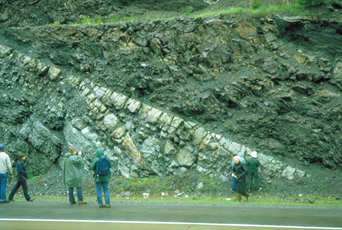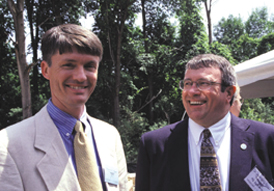Geotimes

Society Page
News
about people and
announcements from
AGI's 40 member societies
|
By
Christina Reed
To
post news in Society Page, send e-mail to car@agiweb.org
with the subject: Society Page.
|
Contents:
Basement rocks
on the horizon
 The American Geological
Institute’s 40th member society, the International Basement Tectonics
Association Inc. (IBTA), is looking for ideas for its 2006 field conference.
The American Geological
Institute’s 40th member society, the International Basement Tectonics
Association Inc. (IBTA), is looking for ideas for its 2006 field conference.
The society is dedicated to helping others facilitate and organize field-oriented
meetings on the subject of basement rocks, the crust of Earth below sedimentary
deposits. The society began in 1974 shortly after the U.S. Geological Survey’s
first Earth-orbiting satellite showed the high degree of lineation in Earth’s
crust. IBTA “is a loosely organized, but dedicated, group of earth scientists
who believe in early fracturing of Earth’s crust and that this pre-existing
fracturing affected and controlled later fracturing in all its many manifestations,”
according to its Web site. Since the first conference in Salt Lake City, Utah,
IBTA has organized 16 meetings around the world resulting in many research volumes.
This photo, taken in 1978, shows a fresh
exposure in the southern Appalachians that will be revisited during the 2004 International
Basement Tectonics Association meeting in Knoxville, Tenn. Pictured is the Copper
Creek fault along Interstate 75. Rome Formation shale and sandstone (Cambrian;
dark colored) are thrust over Chickamauga Group limestone (Middle Ordovician;
light colored). Photo by Robert Hatcher.
In May, the University of Missouri-Rolla hosted an IBTA conference on the relationship
of basement rock to the rock above, with an emphasis on structures of the mid-continent
region. Field trips included studying the involvement of basement structures in
the localization of lead and zinc deposits. “Our society is involved in supporting
a better scientific understanding of the relationship of basement geology to whatever
geologic processes you wish to investigate,” says Krishna Sinha of Virginia
Polytechnic Institute and State University, currently the society’s chief
trustee. But make sure to include a significant field component, he says: “We
want to get outside.”
For 2004, the IBTA has its sights set on Knoxville, Tenn. But the conference itself
will end in Columbia, S.C. Following a symposium in Knoxville addressing the 4-D
evolution of mountain belts and the growth of continents, the participants will
traverse the classic Appalachian orogenic belt from the Valley and Ridge Province
to the Coastal Plain. Geologist Robert Hatcher of the University of Tennessee
is organizing the five-day field trip. “This is going to be an absolutely
first-rate meeting, emphasizing the field-based geologic profile of the southern
Appalachians from the Coastal Plain to the Appalachian Valley,” Sinha says.
Visit the IBTA Web site.
Precambrian production
When John Grotzinger first began studying rocks older than the Cambrian, he wasn’t
expecting his work to open doors in the petroleum industry. Most oil and gas reserves
are found in much younger sedimentary rocks. And looking for oil in rocks that
predate most known life-forms may not sound like a good spot to find natural carbonate
sediments. Indeed, it usually isn’t. But in a wild turn of events, now Grotzinger,
a professor at MIT where he heads the Earth Resources Lab, is pointing out the
best Precambrian oil in town.
Grotzinger’s skill at delving into questions about how changes in the environment
provided opportunities for life on Earth to evolve has gained him considerable
recognition. In April, the National Academy of Sciences elected Grotzinger as
one of its 72 new members. “For me the most gratifying aspect of my career
has been to turn around and watch the growing number of people working in the
Precambrian. There is still so much to do there.”
Indeed, three years ago an opportunity he never expected came knocking. “Oman
on the Arabian Sea has a complicated geological environment — almost all
of the oil and gas is ultimately derived from Precambrian rocks,” Grotzinger
explains. While the country had been producing oil for 30 years, they ran into
complications in optimizing their production and exploration efforts. They needed
geologists familiar with the Precambrian strata, Grotzinger says.
Grotzinger is working with colleagues Sam Bowring and Roger Summons. “The
project in Oman is a wonderful opportunity because it allows us to pursue our
academic interests with immediate application,” he says. The MIT team is
reconstructing past microbial ecologies and mapping the regions where calcifying
metazoans of the Precambrian built reefs, today the reservoirs for oil and gas.
Museum of the Earth underway
Visitors to the Finger Lakes region of central New York next summer should
plan a stop at the Paleontological Research Institution’s (PRI)
Museum of the Earth, currently under construction and scheduled to open May
2003. “The Devonian geology of New York is the best there is,” says
Warren Allmon, director of PRI. “The Finger Lakes are visited by millions
of tourists who come because of the waterfalls, lakes and topography. The museum
will explain the geology to those visitors.”
 Besides the Devonian
of New York, the museum will also feature the Triassic and Jurassic of the Connecticut,
Hudson and Newark valleys, which are part of the Newark Series rock formation,
as well as the Pleistocene of the Northeast. “We’re taking as our
mission to cover the entire history of Earth and life. That’s a huge task
for such a small space so we’re going to focus on the Northeast,”
Allmon says.
Besides the Devonian
of New York, the museum will also feature the Triassic and Jurassic of the Connecticut,
Hudson and Newark valleys, which are part of the Newark Series rock formation,
as well as the Pleistocene of the Northeast. “We’re taking as our
mission to cover the entire history of Earth and life. That’s a huge task
for such a small space so we’re going to focus on the Northeast,”
Allmon says.
Warren Allmon, (left) director of the Paleontological Research Institution (PRI)
and Chris Maples, PRI president, have much to smile about at the announcement
of the Museum of the Earth Campaign on July 8. Photo courtesy of PRI.
Upon entering the 18,000-square-foot museum, visitors will first see a full
skeleton of a modern northern right whale PRI acquired in 1999. Next is the
mural, “Rock of Ages, Sands of Time,” designed by Barbara Page. The
544 tiles, each 11 by 11 inches across, display the geologic record through
the Phanerozoic, with each tile representing one million years. “It’s
a dramatic piece of work. She [Page] spent six years after we commissioned the
project to complete it.” Page also featured the mural in a a book by the
same tittle with Allmon writing the text. The mural is displayed along the wall
next to the ramp leading from the lobby to the lower level where the “Tour
through Time” exhibit begins.
One of the highlights of the Pleistocene section will be the Hyde Park mastodon,
which is 11,480 (plus or minus 60) years old. Larry Lozier discovered the mastodon
in his backyard in 1999 and PRI excavated it with the help of Cornell University.
“Exhibits such as these are not normally what you see in a small town upstate,”
Allmon says. “You’d have to go to Buffalo, Toronto, Pittsburgh, Boston
or New York City to get what we are going to have here.” But in order to
make the museum a reality, PRI is hoping to raise $2.8 million from the public.
Already PRI has $1.8 million from state funding and $4 million from other donors,
including the Park Foundation. The project is expected to cost $10.6 million
with $2 million of the cost including long-term financing. Anyone interested
in donating to the museum’s funding can visit its Web
site.
 Besides the Devonian
of New York, the museum will also feature the Triassic and Jurassic of the Connecticut,
Hudson and Newark valleys, which are part of the Newark Series rock formation,
as well as the Pleistocene of the Northeast. “We’re taking as our
mission to cover the entire history of Earth and life. That’s a huge task
for such a small space so we’re going to focus on the Northeast,”
Allmon says.
Besides the Devonian
of New York, the museum will also feature the Triassic and Jurassic of the Connecticut,
Hudson and Newark valleys, which are part of the Newark Series rock formation,
as well as the Pleistocene of the Northeast. “We’re taking as our
mission to cover the entire history of Earth and life. That’s a huge task
for such a small space so we’re going to focus on the Northeast,”
Allmon says.
 The American Geological
Institute’s 40th member society, the International Basement Tectonics
Association Inc. (IBTA), is looking for ideas for its 2006 field conference.
The American Geological
Institute’s 40th member society, the International Basement Tectonics
Association Inc. (IBTA), is looking for ideas for its 2006 field conference.
